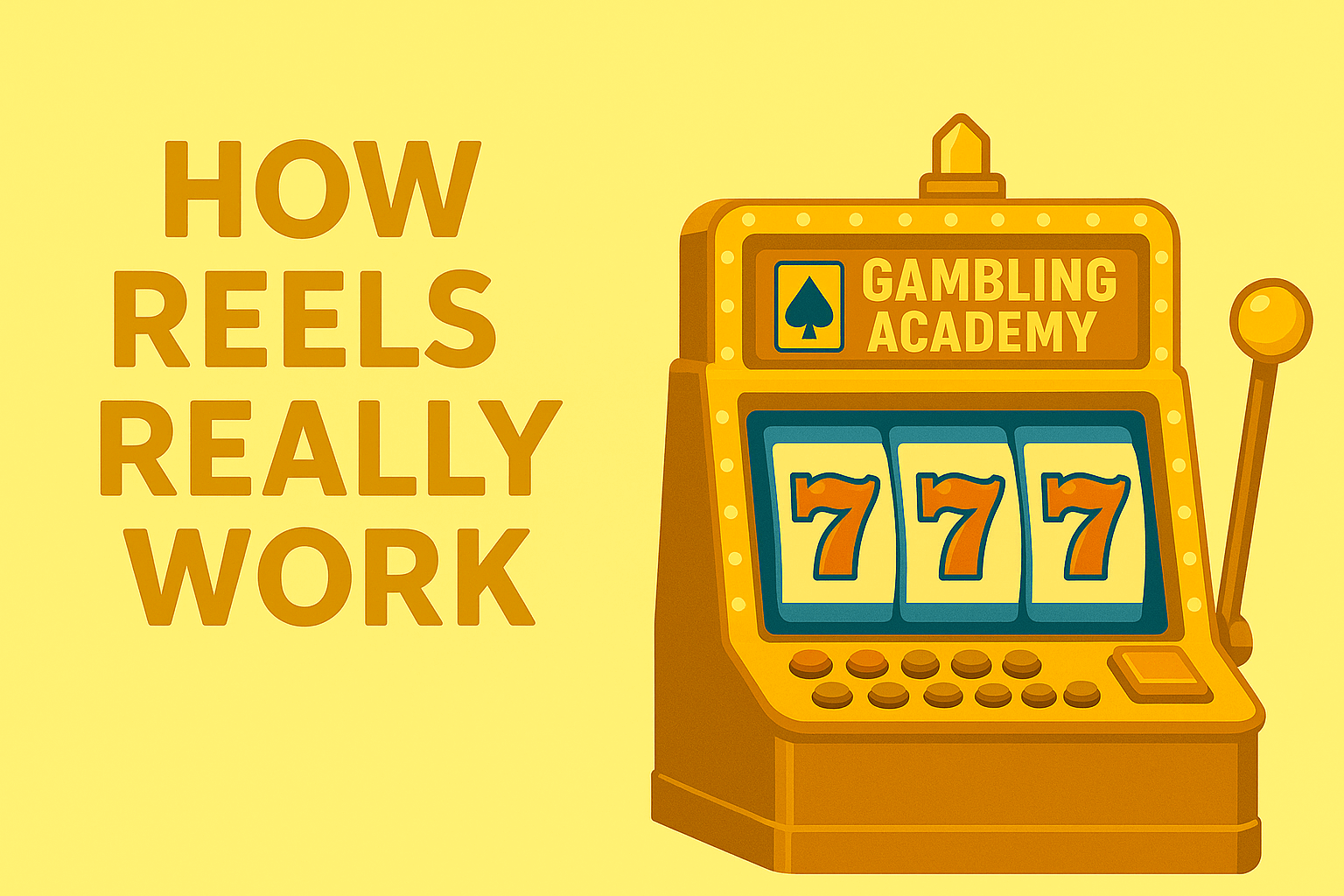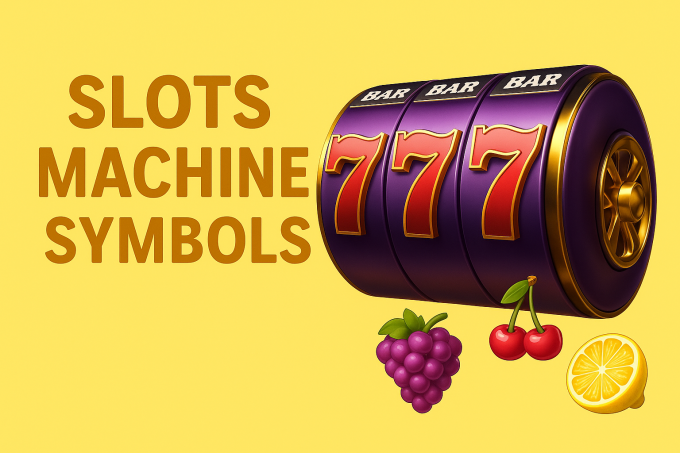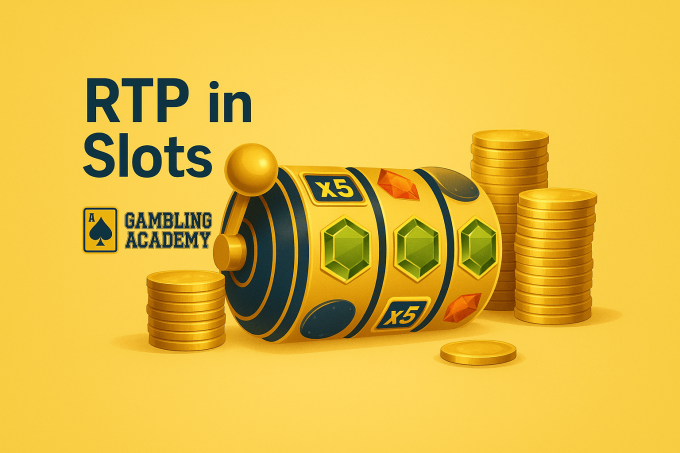If you’ve ever played an online slot, you’ve seen the reels spin and stop to form colorful combinations.
But have you ever wondered how those reels actually work or what makes certain symbols appear together?
Our goal is to help players understand the mechanics behind slots – not just how to play them.
Knowing how reels, symbols, and randomness connect can make your gaming experience more transparent and responsible.
What Are Slot Machine Reels
In simple terms, a reel is a spinning column that displays a set of symbols. Classic slot machines had three reels, each with a limited number of icons such as cherries, bars, and sevens.
When the reels stop, they align symbols across one or more paylines, creating possible winning combinations. Each spin gives you a new set of results – it’s that visual motion of the reels that makes slots exciting and suspenseful.
Modern video slots often have five reels, and some even feature six or seven. These additional reels allow more symbols, features, and paylines, creating complex and entertaining games.
💡 Pro Tip: When you see more reels, it doesn’t automatically mean better odds – it usually means more variety and higher volatility.
Types of Slot Reels
Slot reels come in different styles, and knowing the difference can help you choose a game that fits your pace and taste.
1. Classic Reels
- Usually 3 reels and 1–5 paylines.
- Simple layout and familiar fruit symbols.
- Great for beginners or players who prefer a nostalgic, straightforward experience.
2. Video Reels
- Usually 5 reels, sometimes more.
- Include animations, sound effects, and special features like wilds, scatters, and free spins.
- Offer dozens or even hundreds of paylines.
3. Expanding or Megaways Reels
- Feature dynamic reels, meaning the number of symbols per reel changes with every spin.
- This creates thousands of potential ways to win, which keeps the gameplay unpredictable.
- Perfect for players who enjoy variety and higher volatility.
4. Cascading or Avalanche Reels
- Instead of stopping after a single spin, these reels replace winning symbols with new ones that fall into place.
- If the new symbols create another win, the cascade continues.
- It’s a thrilling chain reaction that gives the feeling of “multiple spins in one.”
💡 Pro Tip: Cascading reels often come with multipliers that increase after each cascade, adding intensity to bonus rounds.
5. Cluster Reels
Cluster slots break away from traditional paylines entirely.
Instead of lining up symbols from left to right, you win by forming clusters — groups of matching symbols touching each other horizontally or vertically.
For example:
- A cluster of 5 identical symbols might trigger a small win.
- A cluster of 15+ symbols could unlock a major payout or bonus feature.
This format feels more like a puzzle or grid game, appealing to players who enjoy strategy and visual satisfaction rather than fixed paylines.
💡 My advice: Cluster slots usually sit in the medium volatility range, giving a balance between frequent wins and engaging bonus potential.
| Reel Type | Reel Count | Main Features | Volatility Level | Ideal For |
|---|---|---|---|---|
| Classic Reels | 3 | Simple gameplay, few symbols, single payline | Low | Beginners or nostalgic players |
| Video Reels | 5 | Animated visuals, multiple paylines, bonus rounds | Medium | Players who enjoy variety |
| Megaways / Expanding Reels | 6–7 (dynamic) | Changing symbol count per spin, thousands of ways to win | High | Risk-takers and bonus hunters |
| Cascading / Avalanche Reels | 5–6 | Winning symbols disappear and new ones drop in | Medium–High | Players who like chain reactions |
| Cluster Reels | Grid (no paylines) | Wins from matching clusters of symbols | Medium | Players who like puzzle-like gameplay |
Inside the RNG: What Really Determines the Outcome
Here’s the biggest secret of slot reels: the reels are just visuals.
What actually decides the outcome is the RNG (Random Number Generator) running behind the scenes.
Here’s how it works:
- When you click “Spin,” the RNG instantly generates a random number sequence – often millions of numbers per second.
- These numbers correspond to positions on each reel’s virtual map.
- The game software translates those positions into symbols that you see.
That means every spin is independent, unpredictable, and unaffected.
🎓 Example:
If a slot has 5 reels and each virtual reel holds 50 symbols, that’s 50⁵ (312,500,000) possible combinations.
That’s why hitting the jackpot is rare — but not impossible.
Reels and Volatility – How They Shape Your Game
Reels themselves don’t change a slot’s Return to Player (RTP) — that percentage is fixed by the game’s design.
However, the number and type of reels do influence the game’s slot volatility — in other words, how often you win and how big those wins are.
Here’s what to expect:
| Reels Type | Typical Volatility | Player Experience |
|---|---|---|
| 3 Reels | Low | Frequent, smaller wins |
| 5 Reels | Medium | Balanced gameplay |
| 6+ Reels (Megaways) | High | Big wins, long dry spells |
Understanding the Balance
- A classic 3-reel slot usually delivers small but steady payouts, making it ideal for players who enjoy relaxed, predictable sessions.
- A 5-reel slot offers a good middle ground – bonus features, multiple paylines, and a moderate win rhythm.
- A 6-reel Megaways slot may feel thrilling and unpredictable, but expect long gaps between wins and high-intensity bonus rounds.
It’s all about risk tolerance and patience – not about “hot streaks” or “luck patterns.”
Once you understand volatility, you can pick games that match your comfort level instead of chasing random outcomes.
💡 My advice: If you like steady play and smaller wins, stay with low-volatility 3-reel slots. If you enjoy risk and excitement, try high-volatility Megaways games, but always set time and budget limits first.
Common Myths About Slot Reels
❌ Myth 1: Slots take turns paying out.
✅ Fact: Every spin is random. Reels don’t “owe” you anything, even after long losing streaks.
❌ Myth 2: The reels are rigged to make you lose.
✅ Fact: Licensed casinos use RNGs audited by independent labs to ensure fairness.
❌ Myth 3: You can time your spins to win.
✅ Fact: RNGs operate constantly – the exact millisecond you click determines the result. Timing or button-press tricks don’t work.
❌ Myth 4: More reels mean higher chances.
✅ Fact: Reels add complexity and volatility, not guaranteed payouts.
How to Choose a Slot Based on Its Reels
Choosing the right slot isn’t about chasing wins – it’s about finding a rhythm that suits you. Here’s how reels can guide that decision:
- Start with classic 3-reel slots if you’re new. They’re clear, quick, and perfect for learning paylines and symbols.
- Move to 5-reel video slots once you understand features like scatters and wilds.
- Explore 6-reel or Megaways slots if you enjoy unpredictable results and bonus-heavy gameplay.
Before you spin, check:
- RTP (Return to Player): Look for 96% or higher.
- Volatility: Match it with your comfort level.
- Bonus features: Pick games that feel fun, not frustrating.
Why Understanding Reels Helps You Play Responsibly
Knowing how reels work doesn’t make you win more – it makes you play smarter.
When players believe myths like “it’s due to pay,” they fall into chasing losses or betting more than planned.
Understanding the real function of reels – as visuals powered by RNGs – helps you stay rational and in control.
Remember:
- Slots are built for fun, not profit.
- Wins are random and rare – that’s what keeps the game fair.
- Always set time and budget limits before you start.
Conclusion
Slot machine reels may look simple, but behind every spin lies complex math ensuring randomness and fairness.
The reels are the stage – the RNG is the director.
Once you understand that, you can appreciate slots for what they are: entertainment powered by probability.
FAQs
1. What’s the purpose of reels in a slot machine?
Reels display symbols that determine winning combinations – they’re the visual layer of RNG-driven results.
2. Do more reels mean higher odds of winning?
No. More reels often increase volatility, not winning chances.
3. What’s the difference between paylines and reels?
Reels are the vertical columns; paylines are the horizontal or diagonal paths that form wins.
4. Are online slot reels fair?
Yes. Licensed casinos use RNGs tested by auditors like eCOGRA or GLI to ensure fair, random outcomes.
5. What are cascading reels?
They remove winning symbols and drop new ones, allowing multiple wins from one spin.
6. Can you predict how reels will stop?
No. RNGs make prediction impossible – each result is independent.
7. How do reels relate to RTP?
Reels influence volatility, but RTP depends on the game’s overall math model, not reel count.
8. Why do some slots use 6 or 7 reels?
To increase gameplay variety and create more ways to win, especially in Megaways or grid-style games.












